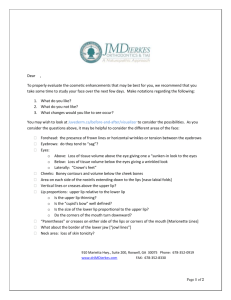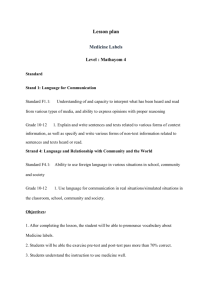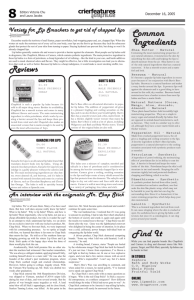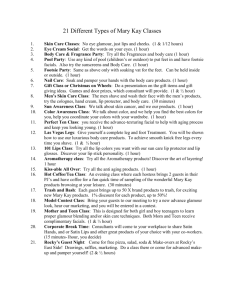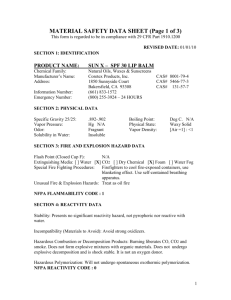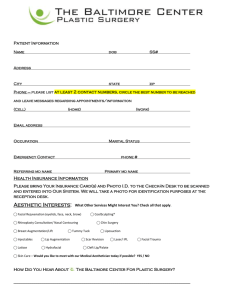Burts Bees
advertisement
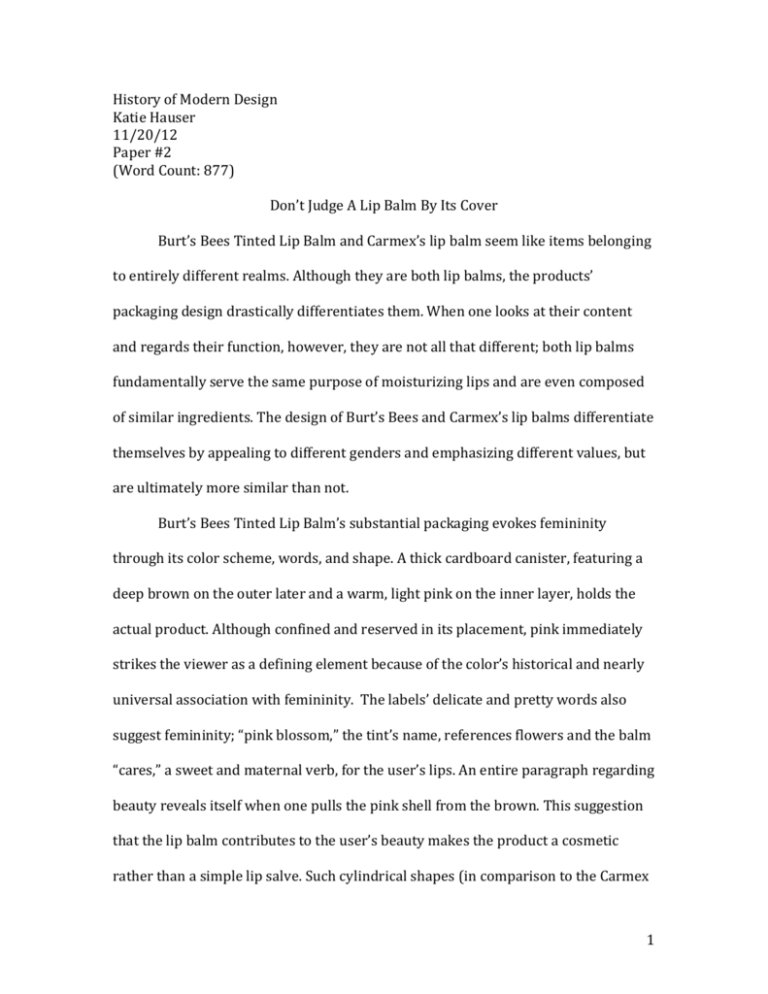
History of Modern Design Katie Hauser 11/20/12 Paper #2 (Word Count: 877) Don’t Judge A Lip Balm By Its Cover Burt’s Bees Tinted Lip Balm and Carmex’s lip balm seem like items belonging to entirely different realms. Although they are both lip balms, the products’ packaging design drastically differentiates them. When one looks at their content and regards their function, however, they are not all that different; both lip balms fundamentally serve the same purpose of moisturizing lips and are even composed of similar ingredients. The design of Burt’s Bees and Carmex’s lip balms differentiate themselves by appealing to different genders and emphasizing different values, but are ultimately more similar than not. Burt’s Bees Tinted Lip Balm’s substantial packaging evokes femininity through its color scheme, words, and shape. A thick cardboard canister, featuring a deep brown on the outer later and a warm, light pink on the inner layer, holds the actual product. Although confined and reserved in its placement, pink immediately strikes the viewer as a defining element because of the color’s historical and nearly universal association with femininity. The labels’ delicate and pretty words also suggest femininity; “pink blossom,” the tint’s name, references flowers and the balm “cares,” a sweet and maternal verb, for the user’s lips. An entire paragraph regarding beauty reveals itself when one pulls the pink shell from the brown. This suggestion that the lip balm contributes to the user’s beauty makes the product a cosmetic rather than a simple lip salve. Such cylindrical shapes (in comparison to the Carmex 1 short, squat jar with a wide opening) also suggest make-up products; a thin, lengthy product requires holding between one’s fingers and applying it directly to the lips, a more delicate activity most associated with applying lipstick, a purely feminine product. An undeniable aspect that suggests cosmetic purpose and therefore femininity is the balm’s second function as a lipstick due to the product’s tint. This aesthetic function is secondary because the products title is “tinted lip balm” versus “moisturizing lipstick” and the company is known for its balms. Such a secondary function reflects its intended consumer and therefore reinforces its design elements. An average straight male would not use tinted products; however, the tint increases appeal to women on the basis that it improves their beauty. Burt’s Bees lip balm differentiates itself through its blatantly feminine design. Carmex, on the other hand, does not strike one as a feminine product. It’s packaging, a small, white, plastic jar with a tin, twist-off lid, does not require the same cosmetic application; rather, one rubs his finger around the relatively large balm surface before bringing his finger to his lips. Instead of references to beauty, caring or other fuzzy words, the jar features its slogan, “It Soothes. It Heals. It Protects.” Such a phrase, disjointed by two-word sentences, evokes action and boldness. Protection also brings masculinity to mind. Interestingly, the jar excludes the words “lip balm,” instead claiming itself a product “for cold sores” and an “external analgesic.” Such words suggests medicine versus cosmetics, therefore, Carmex lip balm appears manlier. Carmex also features its bold logo; “Carmex” in capitalized, sans serif font placed within an irregular red box, grounded by a noticeable black shadow over a bright yellow background. Thick, bold lines and 2 geometric shapes combined with jarring primary colors seem to suggest strength and urgency. Similarly, a lack of harmonious color suggests that Carmex does not try to woo audiences with pleasing, beautiful design. Rather than focusing on beauty, of either the product or user, the Carmex lip balm focuses on longstanding reliability with medicinal significance. The store packaging boasts its “long-lasting relief” for over seventy years, that it is the “#1 Pharmacist Recommended Lip Balm,” includes drug facts, and mentions a “money back guarantee.” Carmex’s lip balm design implies strength, masculinity, and effectiveness. Rather than suggestions of clinical strength, Burts Bee’s lip balm places strong emphasis on its natural quality. Both the plastic container and cardboard container feature, in a bold yellow more striking than the surrounding white text, “100% natural” and the fine print reads “natural personal care products for The Greater Good,” the company’s campaign,1 and the inside paragraph on beauty boasts “natural ingredients.” Interestingly, Carmex also uses a number of Burt’s Bees boasted ingredients, including beeswax, lanolin and cocoa butter. Burt’s Bees eagerly includes icons indicating absence of animal testing and that post-consumer materials contribute to its outer packaging. Carmex also indicates on its packaging’s backside that the product was not tested on animals. Although reassuring that Burt’s Bees extra packaging contains recycled material, this container seems unnecessary, especially considering the brand’s other products’ lack of extravagant packaging. Ultimately, the plastic, which nothing indicates was recycled, containing the lip balm will remain after the cardboard case. Although Burts Bee’s places a 1 Burt’s Bees. “Our Commitment.” http://www.burtsbees.com/c/commitment// 3 large emphasis their natural and social responsibilty as their competitive advantage, Carmex quietly rivals in most areas. Overall, the lip balms seem unnecessarily and somewhat deceptively differentiated. Burt’s Bees tinted lip balm is essentially a Chapstick instead of an exclusively feminine cosmetic and less unique in its natural investment than an average consumer may realize. On the other hand, Carmex may have glorified its lip balm as a medicinal product instead of simply lip balm and is not fundamentally more masculine than any other lip balms. In their similar employment of differentiation and distinction, the lip balms become more alike. 4
